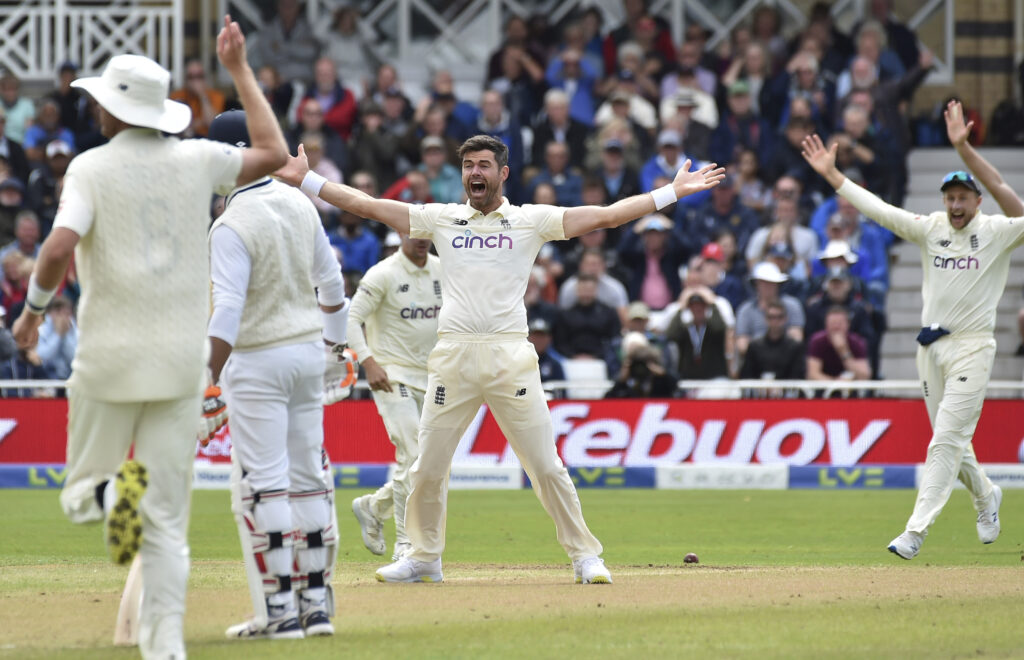
The world’s most successful fast bowler James Anderson of England has called it quits. In his last Test match played against the West Indies at Lords, he took four wickets in two innings and helped England to win the battle by an innings and 114 runs. Anderson could not have hoped for a better way to sign off.
If at all he has any regret, it must be the fact that he missed overtaking Shane Warne’s tally of 708 wickets. He finished with 704 wickets in his Test career which makes him the most successful fast bowler in the history of the game. There are only two bowlers ahead of him – Warne and Muralitharan – and both are spinners.
How will prosperity judge Anderson? England has had great fast bowlers before. There was the lethal Harold Larwood, the fiery Fred Trueman, then Frank Tyson who was nicknamed Typhoon for his blinding speed, the dangerous John Snow and the tall lanky Bob Willis.
Where will James Anderson fit into this list of all-time greats of England? Going purely by statistics he has been more successful than any of his predecessors. But one must also remember that cricket nowadays is a year-round activity. As a result, players play many more matches than the past players did.
Anderson has played 188 Test matches since making his debut on July 30th, 2003 against Zimbabwe. Larwood played in only 21 Tests, Fred Trueman, one-time world record holder, played in 67 Test matches, Frank Tyson in 17, John Snow 49, and Willis 90. Anderson has played in more Test matches than most other bowlers from any country. Even Muralitharan and Warne were not able to play in as many matches as Anderson.
How did he remain fit?
But this brings us to one question. How did Anderson retain the physical fitness to play in so many Tests? He is a fast bowler on whose body there is more stress and strain than on a spinner or batter. A fast bowler’s shoulders, back, knees, and ankles are prone to injury. What has kept Anderson going till the ripe old age of 41?
His methods must be noted
Aspiring young fast bowlers of India would do well to acquire knowledge about the methods that Anderson utilised to prolong his career.

For one thing, he planned his career very well. He never tried to overdo anything. From the beginning, he had a future target in mind. He worked towards a distant objective and never lost focus. Moreover, he devised some personal training routines which served him very well.
His favourite training
His favourite training method is something that he calls a 23-7 routine. The 23 refers to the 23 seconds that he jogs. The 7 refers to a 7-second sprint in which he covers 50 metres. He does this repeatedly on a cricket ground to hone his stamina for bowling long spells. After every ten sprints, he takes a break for two minutes. Then he repeats the cycle.

Every human has his or her weak and strong points in the body. It differs from person to person. Anderson’s weak point was his back. So here too he devised a system that strengthened his back muscles. Sitting on a chair, he lifted his legs off the ground. In that position, he held a medicine ball with both hands and swiveled from left to right in a twisting motion. He says that this exercise kept his back muscles strong. He also did deadlifts with a barbell. After so much hard work, he richly deserved every wicket that he got.
What next for Anderson?
So now that the life of cricket has ended, where will Anderson go next? The answer is easy to find. The fast bowler has already ventured into fashion design. He launched his menswear brand in 2014. This project too has gone well. So it is likely that he will end up being successful off the cricket field too.
As he did with his cricket career, he seems to have planned his retired life also to be a productive and rewarding one. He will not be resting on his laurels. It is likely that after achieving success in one field, he may move on to obtain success in a completely different one.
